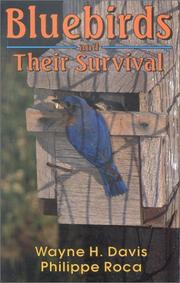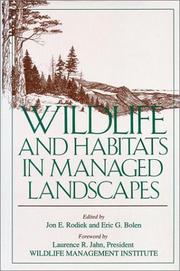| Listing 1 - 10 of 14 | << page >> |
Sort by
|
Book
ISBN: 0241114489 9780241114483 Year: 1985 Publisher: London: Elm tree books,
Abstract | Keywords | Export | Availability | Bookmark
 Loading...
Loading...Choose an application
- Reference Manager
- EndNote
- RefWorks (Direct export to RefWorks)
Book
Year: 1998 Publisher: [Washington D.C.] : USDA Natural Resources Conservation Service, National Association of Conservation Districts, Wildlife Habitat Council,
Abstract | Keywords | Export | Availability | Bookmark
 Loading...
Loading...Choose an application
- Reference Manager
- EndNote
- RefWorks (Direct export to RefWorks)
Habitat (Ecology) --- Wildlife attracting --- Backyard gardens
Book
ISBN: 0002196069 Year: 1977 Publisher: London : Collins,
Abstract | Keywords | Export | Availability | Bookmark
 Loading...
Loading...Choose an application
- Reference Manager
- EndNote
- RefWorks (Direct export to RefWorks)
Garden ecology --- Garden animals --- Weeds --- Natural history --- Wildlife attracting.
Book
ISBN: 9781789147247 1789147247 Year: 2023 Publisher: London : Reaktion Books, Limited,
Abstract | Keywords | Export | Availability | Bookmark
 Loading...
Loading...Choose an application
- Reference Manager
- EndNote
- RefWorks (Direct export to RefWorks)
A provocative call for architects to remember and embrace the nonhuman lives that share our spaces. A spider spinning its web in a dark corner. Wasps building a nest under a roof. There's hardly any part of the built environment that can't be inhabited by nonhumans, and yet we are extremely selective about which animals we keep in or out. This book imagines new ways of thinking about architecture and the more-than-human and asks how we might design with animals and the other lives that share our spaces in mind. Animal Architecture is a provocative exploration of how to think about building in a world where humans and other animals are already entangled, whether we acknowledge it or not.
Architecture --- Human-animal relationships. --- Animal housing. --- Animals --- Wildlife attracting. --- Environmental aspects. --- Habitations.

ISBN: 0813159938 0813170168 9780813170169 0813108462 0813183227 Year: 2008 Publisher: Lexington, Kentucky : The University Press of Kentucky,
Abstract | Keywords | Export | Availability | Bookmark
 Loading...
Loading...Choose an application
- Reference Manager
- EndNote
- RefWorks (Direct export to RefWorks)
A fascinating guide which tells you what you need to know to bring more bluebirds into your life In this detailed how-to book, bluebird expert Wayne H. Davis tells how to attract and care for this beautiful and gentle bird and offers solutions to the most common bluebird problems. Since bluebirds are almost entirely dependent on people for providing nesting sites, the book contains plans for erecting a structure that will attract bluebirds to a safe habitat. Instructions for building and maintaining a ""bluebirds trail,"" complete with drawings of various bluebirds houses and guards against pr
Birds --- Bluebirds --- Bird attracting. --- Bluebirds. --- Sialia --- Turdidae --- Attracting birds --- Birds, Attracting of --- Wildlife attracting --- Birds, Protection of --- Conservation. --- Housing. --- Attracting
Book
ISBN: 9781789146929 1789146925 Year: 2023 Publisher: London, UK: Reaktion Books,
Abstract | Keywords | Export | Availability | Bookmark
 Loading...
Loading...Choose an application
- Reference Manager
- EndNote
- RefWorks (Direct export to RefWorks)
The spider spinning its web in a dark corner; wasps building a nest under a roof: there is hardly any part of the built environment that can’t be inhabited by nonhumans, and yet we are extremely selective as to which animals we allow in or keep out. This book considers many different animals, opening up new ways of thinking about architecture and the more-than-human. Looking closely at how animals produce spaces for themselves, Paul Dobraszczyk asks what we might require in order to design with animals and become more attuned to the other lifeforms that already use our structures. Animal Architecture is a provocative exploration of building in a world where humans and other animals are already entangled, whether we acknowledge it or not.
Architecture --- Relations homme-animal. --- Animaux --- Zoologie. --- Aspect environnemental --- Logement. --- Human-animal relationships --- Animal housing --- Animals --- Wildlife attracting --- Environmental aspects --- Habitations --- Construction animale --- Morphologie architecturale --- Rapport architecture-nature
Book
ISBN: 1623495032 9781623495039 9781623495022 1623495024 Year: 2017 Publisher: College Station
Abstract | Keywords | Export | Availability | Bookmark
 Loading...
Loading...Choose an application
- Reference Manager
- EndNote
- RefWorks (Direct export to RefWorks)
This introductory textbook to wildlife habitat ecology and management offers students and practitioners the basic tools to understand, plan, implement, measure, analyze, and document efforts to improve habitat for wildlife. Providing a step-by-step guide that is adaptable to a range of environmental settings, the authors first lay out the ecological principles applicable to any project. They then take the reader through various sampling designs, measurement techniques, and analytical methods required to develop and complete a habitat project, including the creation of a report or management plan. The authors emphasize key management concepts and provide exercises putting ecological principles into practice. Case studies identify emerging issues that are changing and complicating wildlife habitat management. These include large-scale ecological concerns and their social and political challenges-global climate change, the decline in water quality and availability, loss and fragmentation of habitat, broadening invasive species and diseases, increased human-wildlife conflicts, and urbanization. This practical guide is an invaluable reference for students, land managers, and landowners who are developing and implementing management plans for habitat modification and improvement on both private and public lands.
Wildlife habitat improvement --- Habitat (Ecology) --- Wildlife management --- Habitat improvement, Wildlife --- Animal ecology --- Wildlife conservation --- Wildlife attracting --- Animal habitat --- Animal habitats --- Animals --- Habitats (Ecology) --- Wildlife habitat --- Wildlife habitats --- Ecology --- Animal populations --- Game management --- Management, Game --- Management, Wildlife --- Plant populations --- Wildlife resources --- Natural resources --- Modification --- Habitat --- Habitats --- Management
Book
ISBN: 0813549329 9780813549323 9780813547060 0813547067 9780813547077 0813547075 Year: 2010 Publisher: New Brunswick, N.J. Rutgers University Press
Abstract | Keywords | Export | Availability | Bookmark
 Loading...
Loading...Choose an application
- Reference Manager
- EndNote
- RefWorks (Direct export to RefWorks)
Gardeners, with all good fortune and flora, are endowed with love for a hobby that has profound potential for positive change. The beautifully illustrated Designing Gardens with Flora of the American East approaches landscape design from an ecological perspective, encouraging professional horticulturalists and backyard enthusiasts alike to intensify their use of indigenous or native plants. These plants, ones that grow naturally in the same place in which they evolved, form the basis of the food web. Wildlife simply cannot continue to survive without them-nor can we. Why indigenous plants, you may ask? What makes them so special to butterflies and bees and boys and girls? For Carolyn Summers, the answer is as natural as an ephemeral spring wildflower or berries of the gray dogwood, "As I studied indigenous plants, a strange thing happened. The plants grew on me. I began to love the plants themselves for their own unique qualities, quite apart from their usefulness in providing food and shelter for wildlife. Emphasizing the importance of indigenous plant gardening and landscape design, Summers provides guidelines for skilled sowers and budding bloomers. She highlights . . . The best ways to use exotic and non-indigenous plants responsibly Easy-to-follow strategies for hosting wildlife in fields, forests, and gardens Designs for traditional gardens using native trees, shrubs, groundcovers as substitutes for exotic plants Examples of flourishing plant communities from freshwater streams to open meadows How to control plant reproduction, choose cultivars, open-pollinated indigenous plants, and different types of hybrids, and practice “safe sex in the garden From Maine to Kentucky and up and down the East Coast, Designing Gardens with Flora of the American East lays the "gardenwork" for protecting natural areas through the thoughtful planting of indigenous plants. Finally we can bask in the knowledge that it is possible to have loads of fun at the same time we are growing a better world.
Landscape gardening --- Endemic plants --- Gardening to attract wildlife --- Biodiversity conservation --- Native plant gardening --- Gardening --- Natural landscaping --- Biodiversity --- Biological diversity conservation --- Conservation of biodiversity --- Diversity conservation, Biological --- Gender mainstreaming in biodiversity conservation --- Maintenance of biological diversity --- Preservation of biological diversity --- Conservation of natural resources --- Ecosystem management --- Gardening with wildlife --- Wildlife attracting --- Sanctuary gardens --- Indigenous plants --- Native plants --- Native vegetation --- Plants --- Forests and forestry --- Hedges --- Horticulture --- Parks --- Trees --- Gardens --- Horticultural service industry --- Landscape architecture --- Landscaping industry --- Ornamental horticulture --- Conservation --- Design
Book
ISBN: 1283717212 0520953509 9780520953505 9781283717212 9780520267817 0520267818 Year: 2012 Publisher: Berkeley University of California Press
Abstract | Keywords | Export | Availability | Bookmark
 Loading...
Loading...Choose an application
- Reference Manager
- EndNote
- RefWorks (Direct export to RefWorks)
This attractive, practical guide explains how to transform backyard gardens into living ecosystems that are not only enjoyable retreats for humans, but also thriving sanctuaries for wildlife. Beautifully illustrated with full-color photographs, this book provides easy-to-follow recommendations for providing food, cover, and water for birds, bees, butterflies, and other small animals. Emphasizing individual creativity over conventional design, Bauer asks us to consider the intricate relationships between plants and wildlife and our changing role as steward, rather than manipulator, of these relationships. In an engaging narrative that endorses simple and inexpensive methods of wildlife habitat gardening, Nancy Bauer discusses practices such as recycling plant waste on site, using permeable pathways, growing regionally appropriate plants, and avoiding chemical fertilizers and insecticides. She suggests ways of attracting pollinators through planting choices and offers ideas for building water sources and shelters for wildlife. A plant resource guide, tips for propagating plants, seasonal plants for hummingbirds, and host plants for butterflies round out The California Wildlife Habitat Garden, making it an indispensable primer for those about to embark on creating their own biologically diverse, environmentally friendly garden.
Gardening to attract wildlife --- Gardening to attract birds --- Bird gardening --- Bird attracting --- Gardening with wildlife --- Wildlife attracting --- Sanctuary gardens --- american culture. --- american gardening. --- books about wildlife. --- books for animal lovers. --- caring for wild life. --- coffee table books. --- creating your own ecosystem. --- environmental ecosystems. --- fixing your garden. --- gardening and horticulture landscape. --- gardening for dummies. --- home school science books. --- how to garden. --- ideas for quarantine. --- living ecosystems. --- plants and wildlife. --- protecting wildlife. --- things to do when youre bored. --- transform backyard. --- west region gardening. --- what seeds should i plant.

ISBN: 1610913701 9781610913706 1559630531 9781559630535 1559630523 9781559630528 Year: 1991 Publisher: Washington, D.C. Island Press
Abstract | Keywords | Export | Availability | Bookmark
 Loading...
Loading...Choose an application
- Reference Manager
- EndNote
- RefWorks (Direct export to RefWorks)
Wildlife habitat improvement --- Habitat (Ecology) --- Natural resources --- Landscape ecology --- Land use, Rural --- Management. --- Environmental aspects --- Rural land use --- Land use --- Agriculture --- Ecology --- Animal habitat --- Animal habitats --- Animals --- Habitats (Ecology) --- Wildlife habitat --- Wildlife habitats --- Habitat improvement, Wildlife --- Animal ecology --- Wildlife conservation --- Wildlife management --- Wildlife attracting --- Habitat --- Habitats --- Modification --- Habitat conservation --- United States. --- Officials and employees. --- Conservation of habitat --- Habitat preservation --- Habitat protection --- Preservation of habitat --- Protection of habitat --- Nature conservation --- Conservation --- Protection --- B.L.M. (United States. Bureau of Land Management) --- BLM (United States. Bureau of Land Management) --- U.S. Bureau of Land Management --- US Bureau of Land Management
| Listing 1 - 10 of 14 | << page >> |
Sort by
|

 Search
Search Feedback
Feedback About UniCat
About UniCat  Help
Help News
News